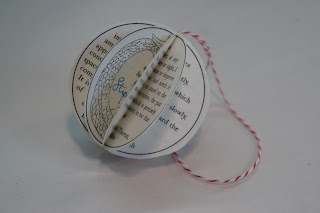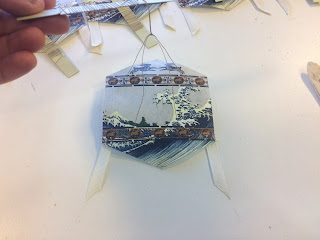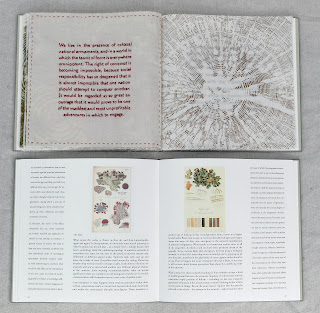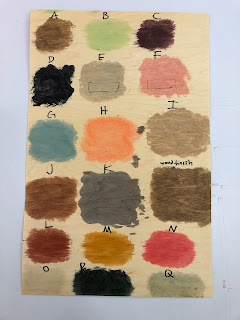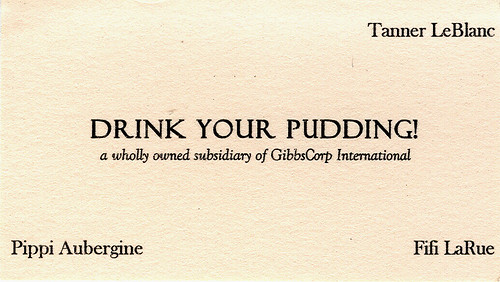The completion of the 2022 / 2023 holiday edition brings with it a completion of the holiday editions as a project. I started this tradition in my second year of graduate school, with the 2003 / 2004 cards, a project to fill the anxious moments of end of term assessments. During the intervening years, they’ve been a source of joy, an expression of curiosity, a way of trying out new techniques and new materials, and a chance to be frivolous in a way that my normal studio practice didn’t always permit. There have been years when the holiday edition has been the only purely creative project that I’ve undertaken; there have been years when my brain was ricocheting in hundreds of directions and the edition delivered well beyond the “holiday season;” there have been years when I’ve finished the edition and felt a great sense of accomplishment at the outcome.
And now it has been twenty years of holiday editions, and I feel like they have fulfilled their purpose. I have a more dedicated creative process which co-exists with my studio process; the edition itself has grown into a fuller artist-book undertaking than I ever intended for it to. In future years I will probably continue with holiday cards, but with reduced ambition, as my focus turns towards other ways of realizing my projects.
Wednesday, January 25, 2023
a score of editions
further thoughts of
Stephanie Gibbs
at
11:17 PM
![]()
as above, so below
The holiday edition has soared through the postal system, arriving in mailboxes near and far, in time for the Lunar new year. Its flight corresponds with the green comet that is wending its way past us this month, and caps a year when things mostly returned to normal, although many of us [me] aren’t quite sure what normal is supposed to be any more.

This year’s edition started with curiosity about two of the options offered by my printing company: the ability to print on mylar [polyester sheets], and the ability to print metallic ink. Could they … print metallic ink on mylar sheets, I asked? They’d try, they said, and: it worked! Since I generally achieve metallic outcomes using a kensol hot foil stamper, and since this would melt mylar rather than embossing images, I wanted to experiment to see what would happen.

From previous years [year of fog, sphere ornaments], I knew that mylar can’t be attached using glue, and so, in my first prototypes, I was concerned with finding a construction method that was adhesive free. Accordion books are traditionally great for this type of material, but I wanted something that played with the reflective qualities of the mylar, in addition to the translucence. While folding samples, I realized that a simple overlapped panel with a slit cut half-way through would allow the two panels to lock into position; and then, by sewing through the center folds, I could use a modified pamphlet stitch to anchor the star into shape.


Last year’s edition was the sea, and it felt appropriate for this year’s edition to be the stars. During the summer, photographs from the Hubble telescope made headlines; the year before, I had read a novel re-imagining the life of Kepler’s mother, who was tried as a witch while he was the astronomer royal. I’ve always loved the idea of the music of the stars, and believe that if any composer has the ability to translate that movement into sound, it would be the precision and balance of Bach, and found a manuscript of the Well Tempered Clavier to convey that song in these cards. While playing with the structure of the star, I added a belt, an echo of Saturn’s rings, and saw this as an opportunity to incorporate a line of text from Emerson’s essay, Circles: Our life is an apprenticeship to the truth that around every circle another can be drawn; that there is no end in nature, but every end is a beginning; that there is always another dawn risen on mid-noon, and under every deep a lower deep opens. The elements when brought together as a whole allow you to go deeper, into whichever direction you find inspiring.

While it seems like bad astronomy to have both rings and a comet tail, I liked the idea of folding a paper tassel to have both the message of well wishes for the new year and the colophon information dancing below the star, and was thrilled to discover that the Thai metallic paper from Hiromi Paper can be run through a standard laser printer. 

Once I received the printed paper inner star, and the printed mylar outer star, I created two jigs for scoring fold lines, punching sewing holes, and cutting slits for the paper ribbons. The inner star is smaller than the outer star, so that it nests inside the mylar, and so the measurements needed to be recalculated for each. After scoring and then folding the pages, I cut them into individual strips and began the initial stages of assembly.
The tassels were cut and folded; the ribbon rings woven through the mylar outer wrappers, and the wrappers locked into position; and the paper interior folded and also held in place with a slit-lock.
The tassels and the hanging ribbon were attached to the stars at the same time that the outer and inner layers were sewn together, using a modified pamphlet stitch with a backstitch element to anchor the star into the correct position.
Since the post office has a tendency to destroy my cards in transit, they always receive some type of wrapper to protect them on their way. This year the wrapper also included instructions for opening up the star for display — since I know it isn’t always obvious what, exactly, the holiday edition is.
My cats received a mini-edition of their own: originally, I was going to make a special “cats of recipients” edition-within-an-edition, but, even though I anticipated this year’s project being substantially less involved than last year’s, it still took a month to assemble after receiving the printed elements, and so the feline mini-edition was allowed to exist purely in the “conceptual” state.
Wishing you — and your cats — a very happy new year!
further thoughts of
Stephanie Gibbs
at
11:02 PM
![]()
Saturday, April 9, 2022
System Theory
Two volume artist’s book in clamshell box. A study of lichen as a system, and of society as a system: a lens for examining how the organism requires thinking and acting beyond the immediate needs of the individual.
Hand painted wood veneer covers [designs vary], 6 hand embroidered pages, 8 woodcut prints, 6 woodcut collages digitally printed on fabric, and two essays: Twelve Readings on the Lichen Thallus by Trevor Goward, and A System of Logic by John Stuart Mill, with historic lichen imagery. The hand-embroidered pages are the text from the Sociology entry of The Encyclopaedia Britannica 11th edition, which describes society as a organism working towards the health of the whole over the desires of the individual.
9"x 9". Limited edition of 10. Two volumes in clamshell box. Ships 7/15/2022.
In the early autumn of 2021, I became fascinated by the unresolved nature of the definition of lichen: how it is a combination of algae and fungus, and how it forms a third, completely different organism than would be possible without this combination, and how science is still rather flummoxed by many of the characteristics of it: is it an organism? Is it mostly a fungus? Is it a parasite? Is it mutually beneficial? Different scientists have different interpretations, and it was only at the invention of more powerful microscopes in the late 18th century that Erik Acharius teased out the component parts. I was also interested in their functionality: the time scale they operate in, by the climates they grow in, how they display interdependence into a new whole.
One of the books about lichen that I most enjoyed was Kem Luther’s book “Boundary Layer,” which including a reference to the work of a Canadian scientist, Trevor Goward, who wrote a series of essays entitled Twelve Readings on the Lichen Thallus. These personal essays combine science with storytelling to explore the nature of lichens, and come to the conclusion that they can best be experienced as systems rather than as individual parts acting in self interest. Trevor Goward very kindly gave me permission to reprint his essays, which I abridged in the desire to tell the story that interested me: the story of a system formed of interdependent parts.
This led me to start searching for other metaphor that explored the nature of systems: what would make lichen something that other people could conceptualize, who weren’t already knowledgeable? What would make lichen larger than a biological curiosity? I started looking into other examples of networks and systems: neuroscience, brain theory and the nervous system; transportation hubs; samples of manufacturing using unexpected materials; and then, while using google books and the internet archive and searching using the term “system theory,” I came across John Stuart Mill’s book which established social science, A System of Logic.
This is, honestly, a very long book that spends a very long time talking about the nature of logic and the establishment of scientific norms, but, once you are through all the introductory matter, there is a compelling section that applies the nature of logical thinking to the study of human rights and society — in short, the establishment of sociology as a field — the study of humanity and politics as a system.
The text of the book is the abridged essays by Goward; the borders of the pages have the abridged text of Stuart Mill. Throughout the book, imagery from the early scientists has been brought into the page designs: the botanical illustrations of Acharius, Nageli, and Westrings.
The same way that volume 1 has three disparate elements [algae, fungus, cyanobacteria; Goward, Stuart Mills, historic botanical plates], so does volume two: embroidered text, woodblock prints, and digital collages.
Volume two of the book uses a more poetic exploration of the visual nature of lichen, combined with the most laborious and slow-growing method of creating text on the page that is possible — hand embroidery.
Combining materials, paper, wood, fabric mirrors the way that lichen is a plant-like growth on rocks and trees — and inspired by the fabric books of Louise Bourgeois for inspiration in how cloth could work as a book structure. [New York Times | MoMA [original] | [edition] ]
I was interested in incorporating a woodgrain print element to the project, based on the photograph from the nature hike [above] with the lichen growing on a felled trunk. The first step was to explore how to create a print from a piece of wood. There was a great online forum of Canadian woodworkers who had a conversation where sanding the wood smooth and then using a wire brush drill attachment to pull out the soft grain so that the rings would form prints. My studio was partitioned into a special sanding area (plastic cloths hanging from the ceiling) and sanding and wire-brushing commenced.
These sanded blocks were then turned into rubbings using graphite on paper, then dropped into Photoshop, and digital collages were made using the rubbings and the hand-dyed covers [see below]. The resulting collages were then digitally printed onto organic cotton, which was then dyed in the studio in a bath of acorn dye [acorns collected by my nephews over Thanksgiving], then cut down into panels for the books.
Embroidery was always a foundational part of the conception of this project: it is text literally growing on the substrate, the way that lichen grows on trees and rocks, and it is slow, remarkably slower, slower even than calligraphy or using handset type; it operates at the scale that lichen grows. It took me some time to develop how I wanted the embroidery to work with the woodcut collages: I wasn’t certain what text or imagery was most appropriate, but remembered that I had a copy of the famous Encyclopaedia Britannica 11th Edition, and the article on Sociology fit in cleanly with the message that I sought through volume one:
It is a feature of organisms that as we rise in the scale of life the meaning of the present life of the organism is to an increasing degree subordinate to the larger meaning of its life as a whole. The efficiency of an organism must always be greater than the total of its members acting as individuals.
I extracted a total of six excerpts from the text, which narratively illustrate this concept of the sum being greater than the parts. After each pane was embroidered, it was trimmed with a rough edge, formed into signatures with a second embroidered panel and two collages, and the outer edges were stitched, in pursuit of the softer edge finish this provides.
Bringing the woodcut element into sharper relief, inked woodblock prints were created by printmaker Catherine Ulitsky, who accompanied me on the lichen walk through the Hawley Bog pictured earlier. In addition to being a trained professional printmaker, Catherine also has a long history of interest in the natural environment and our relationship with it, and her selections of woodblocks and thoughtful inking bring a sharp visual focal point into the edition, providing a foundation for the embroidery and collages to grow in relation to.
The covers of
the books are maple veneer panels, hand dyed in a range of colors and
patterns to resemble the various palettes and forms that lichen takes,
on trees and on stones. Each cover is different; while the covers of
volume one and volume two are in relationship to each other as far as
tone, it was never the intention to have them match or coordinate.
Nature is too diverse for me to be interested in that as a solution. A
selection of these panels were used as a base and color layer for the
digital collages of volume two.
The same way that lichen is a
relationship between disparate elements that forms a complex, functional
system, this book incorporated the skills and talents of a group of
people that I am thrilled were graciously involved in the project.
Without Trevor Goward’s essay, Catherine Ulitsky’s woodblock prints, and
the talented handcraft of my studio assistant, Kayla Mattes, this
project would not have unified into the whole presentation that it
offers the reader.
further thoughts of
Gibbs Bookbinding
at
10:48 PM
![]()














